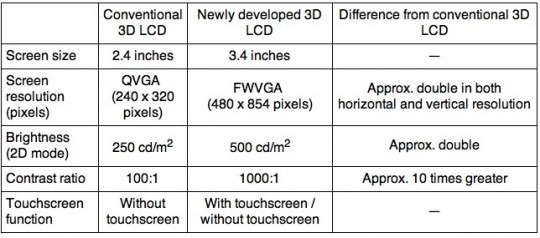Sharp 3D Touchscreen LCD Another Nintendo 3DS Contender
With Nintendo's 3DS gaming handheld on the horizon, any glasses-free 3D display technology announcement is being examined closely. Back in March we pondered whether Nintendo might use Hitachi's 3D system, based on the company already being a DSi screen supplier, but now Sharp – who also supply Nintendo with LCDs – have announced their own 3.4-inch 3D LCD technology. As for whether it works, Akihabara News reckon it's "REALLY impressive" and the equal of systems requiring 3D glasses.
Sharp's system uses a parallax barrier system – basically a series of vertical slits which control what light reaches which eye – and can be used in both portrait and landscape orientation. It's switchable between 2D and 3D models, and the company reckons it's the brightest such display so far, at 500cd/m2.
Two versions are planned, one with a touchscreen and the other without – remind you of any particular gaming handheld? – and mass production is expected to begin in the first half of the 2010 fiscal year. No word on what sort of pricing the panels might carry, but they're apparently the same thickness (even with a touchscreen layer) as regular 2D displays.

Press Release:
Sharp Develops 3D Touchscreen LCD—Switchable Between 2D and 3D Modes—with Industry's Highest Brightness*1Enables 3D Images Without the Need for Special Glasses
Sharp Corporation has developed a 3D touchscreen LCD featuring the industry's highest brightness that can switch between 2D and 3D modes. Users can view 3D images without the need to wear special glasses, making this LCD ideal for mobile devices such as digital cameras, mobile phones, and smartphones.
The newly developed 3D LCD uses a parallax barrier system to display 3D images. This parallax barrier, which has a series of vertical slits, is incorporated into an ordinary LCD to control the path of light reaching the right and left eyes, thus creating a sense of depth. However, the conventional 3D LCD with this system had difficulty in displaying high-quality images in 3D mode.
The 3D LCD developed by Sharp at this time significantly improves image quality by achieving both high brightness and low crosstalk*2 thanks to advances in CG-Silicon technology*3 and optimization of the parallax barrier. Advances in CG-Silicon technology have shrunk the wiring width within the LCD panel, allowing more light to pass and doubling the brightness (to 500 cd/m2, the industry's highest) compared to the conventional model*4. In addition, optimizing the parallax barrier design has increased the efficiency of light, thereby dramatically reducing crosstalk. Also, the thickness of the LCD module is about the same as conventional 2D displays even though it is a touchscreen display. As 3D images can be displayed in both portrait and landscape screen orientations, it is ideal for sophisticated mobile devices such as smartphones.
Sharp has also developed a non-touchscreen 3D LCD and will start its mass production in the first half of fiscal 2010.
*1 As of April 2, 2010, for 3D LCD modules for mass-produced mobile devices.
*2 Double images created by overlapping of left and right images.
*3 CG-Silicon technology is an LCD process technology that uses high-performance, crystalline silicon with electron mobility up to 600 times faster than ordinary amorphous silicon and up to six times faster than low-temperature polysilicon. Developed jointly by Sharp and Semiconductor Energy Laboratory Co., Ltd. (head office: Atsugi-shi, Kanagawa, Japan; Shunpei Yamazaki, President).
*4 LCD that Sharp began mass-producing in June 2003.
